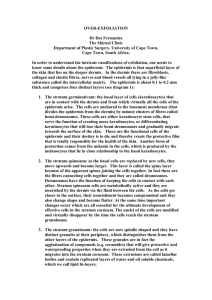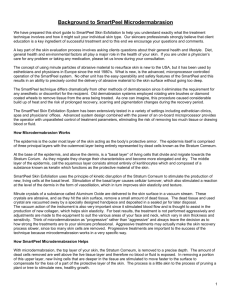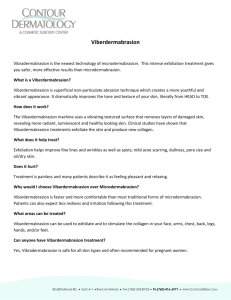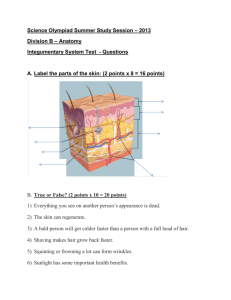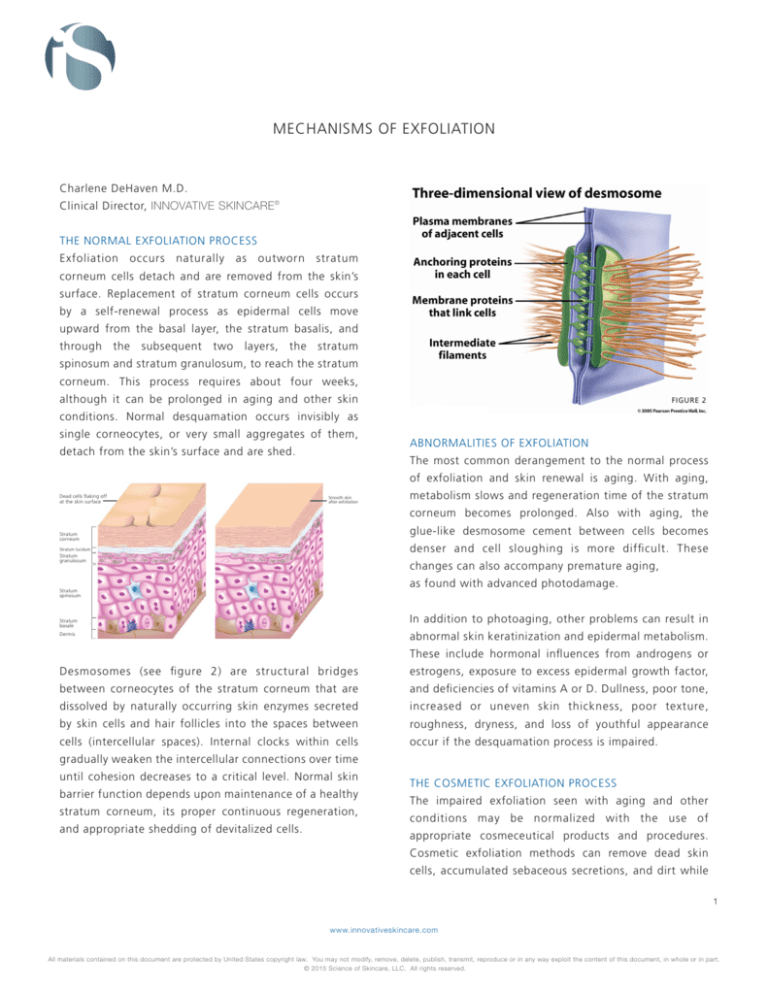
MECHANISMS OF EXFOLIATION
Charlene DeHaven M.D.
Clinical Director, INNOVATIVE SKINCARE ®
THE NORMAL EXFOLIATION PROCESS
Exfoliation
occurs
naturally
as
outworn
stratum
corneum cells detach and are removed from the skin’s
surface. Replacement of stratum corneum cells occurs
by a self-renewal process as epidermal cells move
upward from the basal layer, the stratum basalis, and
through
the
subsequent
two
layers,
the
stratum
spinosum and stratum granulosum, to reach the stratum
corneum. This process requires about four weeks,
although it can be prolonged in aging and other skin
FIGURE 2
conditions. Normal desquamation occurs invisibly as
single corneocytes, or very small aggregates of them,
detach from the skin’s surface and are shed.
ABNORMALITIES OF EXFOLIATION
The most common derangement to the normal process
of exfoliation and skin renewal is aging. With aging,
Dead cells flaking off
at the skin surface
Smooth skin
after exfoliation
metabolism slows and regeneration time of the stratum
corneum becomes prolonged. Also with aging, the
glue-like desmosome cement between cells becomes
Stratum
corneum
denser and cell sloughing is more difficult. These
Stratum lucidum
Stratum
granulosum
changes can also accompany premature aging,
as found with advanced photodamage.
Stratum
spinosum
In addition to photoaging, other problems can result in
Stratum
basale
abnormal skin keratinization and epidermal metabolism.
Dermis
These include hormonal influences from androgens or
Desmosomes (see figure 2) are structural bridges
estrogens, exposure to excess epidermal growth factor,
between corneocytes of the stratum corneum that are
and deficiencies of vitamins A or D. Dullness, poor tone,
dissolved by naturally occurring skin enzymes secreted
increased or uneven skin thickness, poor texture,
by skin cells and hair follicles into the spaces between
roughness, dryness, and loss of youthful appearance
cells (intercellular spaces). Internal clocks within cells
occur if the desquamation process is impaired.
gradually weaken the intercellular connections over time
until cohesion decreases to a critical level. Normal skin
barrier function depends upon maintenance of a healthy
stratum corneum, its proper continuous regeneration,
and appropriate shedding of devitalized cells.
THE COSMETIC EXFOLIATION PROCESS
The impaired exfoliation seen with aging and other
conditions may be normalized with the use of
appropriate cosmeceutical products and procedures.
Cosmetic exfoliation methods can remove dead skin
cells, accumulated sebaceous secretions, and dirt while
1
www.innovativeskincare.com
All materials contained on this document are protected by United States copyright law. You may not modify, remove, delete, publish, transmit, reproduce or in any way exploit the content of this document, in whole or in part.
© 2015 Science of Skincare, LLC. All rights reserved.
providing a gentle deep cleansing that returns skin to a
Beta-hydroxy acids have the unique characteristic of
more
This
being oil soluble. Alpha-hydroxy acids do not share this
promotes epidermal regeneration while helping skin
qual i ty. O i l /l i pi d s ol ubi l i ty al l ows pen et r at ion of
regain softness, uniform texture, and suppleness.
beta-hydroxy acids into sebum and therefore facilitates
youthful
physiology
and
appearance.
a deep-cleansing of the pore of the pilosebaceous unit
Cosmetic exfoliation may be accomplished by chemical
and hair follicle. Since the pilosebaceous unit is the key
or mechanical means. Chemical exfoliation methods
structure in the development of acne, beta-hydroxy
include acids, non-acid peels, enzymes, or other agents.
ac i ds are parti c ul arl y benefic i al i n this disorder.
Mechanical exfoliation may be accomplished using a
Cleansing of the pore is also important post-procedure
device or small particles of various types. Both chemical
to prevent milia formation, and in shrinking pore size for
and mechanical exfoliation may be performed as an
cosmetic and skin health reasons.
in-office procedure or at home, depending on the type
and strength of treatments desired. The remainder of
Enl arged
this discussion will include the gentler, more physiologic
pilosebaceous follicles. These may appear either as
types of exfoliation rather than the aggressive peeling
conical openings or plugged with debris in comedones.
procedures performed more commonly in times past.
Many factors contribute to enlarged facial pores
These currently preferred exfoliation methods also work
including ethnic background, environmental factors
well with a variety of home care products.
(season of the year, humidity, temperature), hormonal
pores
are
the
di l ated
openings
of
fluctuations, and aging.
Hydroxy Acids
Hydroxy acids are of two chemical types, alpha-hydroxy
Many women are distressed by large pores. As a 2014
acids and beta-hydroxy acids.
Harris Poll of more than 2000 women revealed, 38% of
all women think their pores are too big. This number
Alpha-hydroxy acids (AHAs) may be obtained from
rises to over 50% in Japanese women between the ages
synthetic sources or from natural sources. Natural
of 20 and 30 and to 48% in Latinas. Thirteen percent of
botanical sources are often preferred by users for
women hav e av oi ded taki ng photos because of
tolerability and gentleness. Botanical sources include
perceived large pore size. Twenty-one percent of women
sugarcane, fruits, and mixed fruit acids.
say they began noticing their pore size between the ages
of 15 and 20. Furthermore, 73% of women say they
AHAs are gentle and effective desquamation agents.
have not yet found a product effective in shrinking pore
They act not only on the skin’s outer surface but can
size. Cosmeceutical products incorporating salicylic acid
penetrate to some depth in epidermis to facilitate a
effectively would be desirable to this large group of
somewhat deeper exfoliation. This stimulates skin
consumers looking for improvements in pore size.
renewal and shortens epithelial regeneration time, thus
more closely approximating a younger physiology.
Although previous opinion said otherwise, inflammation
Collagen synthesis can also be stimulated.
and degeneration of skin is not required to produce a
controlled exfoliation resulting in epidermal and dermal
Salicylic acid is a beta-hydroxy acid (BHA) which may
regeneration. Furthermore, this permits use of these
be de r iv e d sy nt h e ti c a l l y o r o b ta i n e d b o ta ni c al l y.
products in ethnic groups subject to hyperpigmentation,
Furthermore, it is anti-inflammatory and thereby provides
including Asians, Latinas, African-Americans, and those
other benefits in a variety of skin conditions. Since most
of Mediterranean descent.
skin conditions, including aging, activate inflammatory
pathways, salicylic acid has wide applicability.
2
www.innovativeskincare.com
All materials contained on this document are protected by United States copyright law. You may not modify, remove, delete, publish, transmit, reproduce or in any way exploit the content of this document, in whole or in part.
© 2015 Science of Skincare, LLC. All rights reserved.
Enzymes
EXFOLIANT COMBINATIONS
Enzymes may be synthetic or from natural sources. They
Combining the above groups of exfoliants, each with
work by dissolving skin cells and facilitating cell
different mechanisms of action, can provide synergistic
renewal, shortening epithelial transit time. Natural
effects. TRI-ACTIVE EXFOLIANT by iS CLINICAL contains
s ourc e s of bot a n i c a l e n zy me s , a s i n T R I - ACT I VE
hydroxyacids, enzymes from papaya and pineapple, as
EXFOLIANT, are papaya and pineapple which are sources
well as uniform, non-traumatizing cellulose particles.
of papain and bromelain, respectively. Using plant
TRI-ACTIVE EXFOLIANT stimulates youthful regeneration
sources also gives antioxidant and other protective
of epithelium, gently and thoroughly cleans and shrinks
properties to the product.
pores, and also provides non-irritating mechanical
exfoliation. All of these ingredients are friendly to both
Mechanical Exfoliants
human skin and the environment.
Mechanical exfoliation can be achieved with devices,
including microdermabrasion, or with small exfoliant
particles including ground seed particles, pulverized
shells or other vegetal materials. The process of
mechanical exfoliation loosens the outer corneocytes of
the stratum corneum.
OVER-EXFOLIATED SKIN
Mechanical and/or chemical exfoliation assists to skin may
be carried too far resulting in excessive stratum corneum
thinning, shininess, irritation, redness, sensitivity, and
telangiectasias (dilated blood vessels). Products and
A newer vegetal source of mechanical exfoliants is
cellulose. Cellulose is the material composing the cell
walls of plants. Small particles of cellulose, if correctly
formulated, are uniform in size, have smooth edges, and
are non-irritating while still being very effective.
procedures must be carefully chosen to avoid this
“over-processed” look. With repeated over-exfoliation,
barrier function is diminished and dehydration occurs in
addition to many other potential problems.
Our industry has entered the era in which minimal
The pa r t ic ula r t y p e o f ce l l u l o s e p a rti cl e s us ed i n
iS CLINICAL’s TRI-ACTIVE EXFOLIANT has been shown to
be non-abrasive. Furthermore, in clinical studies of this
ingredient, if excessive pressure is applied during
application, the cellulose particles begin dissolving thus avoiding any trauma or irritation to skin. These
particles have a very narrow size distribution, ensuring
uniform exfoliation. They are friendly not only to skin,
but also to the environment, containing none of the
plastics that have been banned from cosmetic use due to
accumulation in the earth’s waterways.
down-time as well as optimal results are desired. These
goals can be achieved with the new formulation
technologies, products, and procedures. It is no longer
accepted dogma that stronger peels are always better. It
is also known that peeling does not have to be clearly
visible to be present, since the desquamation and
release of corneocytes can occur on a microscopic level.
Modern results are also seen much more quickly in a
matter of days or even immediately. Clients and patients
will no longer tolerate extended periods of discomfort,
weeping skin, and peeling sheets of epidermis – and,
fortunately, these side effects are no longer required for
Fragmented seeds, such as apricot pits, have been
widely used for mechanical exfoliation but contain
excellent results and returning skin to a younger
epidermal physiology.
rough, irregular edges. These cause micro-scratches on
the skin’s surface and are irritating, pro-inflammatory,
and pre-dispose to complications of infection. They can
be particularly dangerous for spreading infectious
processes in acne or other inflammatory conditions
where potential infection is a concern.
3
www.innovativeskincare.com
All materials contained on this document are protected by United States copyright law. You may not modify, remove, delete, publish, transmit, reproduce or in any way exploit the content of this document, in whole or in part.
© 2015 Science of Skincare, LLC. All rights reserved.
REFERENCES
Nguyen T. Dermatology procedures: microdermabrasion and
chemical peels. FP Essent. Nov 2014;426:16-23.
Stenzel T. Three chemical peel myths that derail your services.
Skin Inc. Aug 27, 2014.
More women than ever looking at pore size. GCI Magazine.
June 10, 2014.
Stevenson K. Enlarged Facial Pores. Cosmetics & Toiletries.
Feb 21, 2014.
Zone GC. Peel Science. Skin Inc. Feb 2014;40-8.
Howard DL. Sloughing Off. Les Nouvelles Esthetiques. Sep 2013.
Allison R. Peel away the mysteries of acids. Skin Inc. Mar 2013.
Kornhauser A, Coelho SG, Hearing VJ. Applications of hydroxyl
acids: classification, mechanisms, and photoactivity. Clin
Cosmet Investig Dermatol. Nov 24, 2010;3:135-42.
Smith WP, Bishop M, Gillis G, Maibach H. Topical proteolytic
enzymes affect epidermal and dermal properties. Int J Cosmet
Sci. Feb 2007;29(1):15-21.
Bari AU, Iqbal Z, Rahman SB. Tolerance and safety of superficial
chemical peeling wih salicylic acid in various facial
dermatoses. Indian J Dermatol Venereol Leprol.
2005;71:87-90.
Briden ME. Alpha-hydroxyacid chemical peeling agents: case
studies and rationale for safe and effective use. Cutis.
Feb 2004;73(2 Skuppl):18-24.
Imayama S, Ueda S, Isoda M. Histologic changes in the skin of
hairless mice following peeling with salicylic acid. Arch
Dermatol. Nov 2000;136(11):1390-5.
4
www.innovativeskincare.com
All materials contained on this document are protected by United States copyright law. You may not modify, remove, delete, publish, transmit, reproduce or in any way exploit the content of this document, in whole or in part.
© 2015 Science of Skincare, LLC. All rights reserved.

